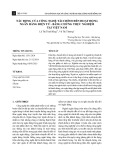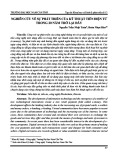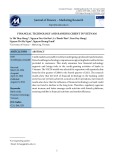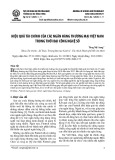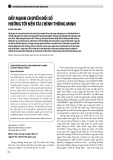
23
Sinh viªn
TAØI CHÍNH DOANH NGHIEÄP Taäp 02/2024
Developing Open banking in Vietnam:
Opportunities and challenges
Nguyễn Ngọc Mai; Trịnh Như Hồng Nhật - CQ59/11.12CLC
n recent years, the fourth industrial revolution has been progressing strongly,
resulting in numerous accomplishments that have profound implications for various
industries and sectors of the economy, including the banking sector. In the context of
the digital transformation boom, traditional banking models have undergone modifications
and advancements with the aim of boosting competitiveness and efficiency, leading to the
emergence of the Open banking . The open banking concept represents a relatively
optimal business model in line with the trends and demands of the digital era, allowing
banks to expand their operations by offering digital products and services conveniently,
comprehensively, cost-effectively, and reaching a more diverse customer base, both
domestically and internationally.
What is open banking?
In the traditional business model, banks typically manage and safeguard information
by storing all transaction data and customer account details. In contrast, open banking
allows banks to utilize and share their customers’ financial data, including transactional
histories and account details, with third parties such as other financial institutions, Fintech
companies or electronic payment services through Application Programming Interface
(API). This sharing is carried out with the customer’s agreement.
The main objective of open banking is to promote competition, encourage the
development of financial services, and improve the customer experience. It enables third
parties to use the shared data to create solutions that assist individuals in more conveniently
managing their finances, conducting transactions and accessing financial information.
Open banking operates under government regulations to ensure privacy and data
security. This model must strictly adhere to data protection laws and security standards to
safeguard customer information.
How does open banking operate?
Open banking utilizes API (Application Programming Interface) technology for its
development. In the context of APIs, the term application refers to any software that features
distinct functionalities. An interface serves as a service contract between two software
applications. Consequently, it can be understood that an API functions as a mechanism for
linking two software components to facilitate the exchange of information and data.
Open API not only eliminates the limitations on interactions between involved parties
but also promotes the evolution of business models. This technology enables third parties to
I

24
Sinh viªn
Taäp 02/2024 TAØI CHÍNH DOANH NGHIEÄP
access open data or securely access an organization’s closed data with the owner’s consent
and compliance with relevant legal regulations. In this particular context, third entities often
refer to technology startups and online financial service providers. It is due to this
convenience of APIs that they are incorporated into the functioning of open banking.
In this model, banks will provide their services via open APIs and collaborate with
partners to construct an ecosystem that satisfies the needs and demands of users. The
utilization of open APIs facilitates collaborations between banks and third parties, thereby
improving the financial experience of customers. Specifically, by connecting with partner
applications, banks can gain access to a diverse customer base at a reasonable cost through
open banking. This reduces the time required to seek out and attract customers.
In Vietnam, open banking has been widely and actively implemented. Banking
applications, including mobile banking and internet banking, have improved user
payments via open banking by incorporating functionalities such as contactless payment
and QR codes. In addition to serving as an electronic banking application, open banking
also offers various non-banking utility services, including online shopping, bill payments,
and network service registration.
Benefits of open banking
Benefits for businesses
First, open banking allows immediate payments and minimizes transaction expenses
for businesses. Instant transfers between accounts become feasible due to the rapid
movement of money. This also assists companies in increasing the rate of payment
acceptance, enabling them to expand their business operations. Moreover, by eliminating
card payments, enterprises can reduce transaction costs, as card providers may charge
various fees to accept card payments.
Second, open banking enhances user customization. Open banking allows businesses
to access a wealth of consumer data, enabling them to provide more personalized services
to their clients.
Benefits for users
Customers’ financial experiences are improved through the use of open banking. It
simplifies financial management for users as financial services have shifted online. Moreover,
by allowing the sharing of information with user consent, open banking enables users to access
a wider range of services through a single application. Security is another advantage of open
banking. All third-party providers must meet the highest security standards to operate in the
market, ensuring consumers can confidently utilize open banking services.
Benefits for banks and financial organizations
Open banking has facilitated partnerships between financial technology (fintech)
firms and banks. In the rapidly evolving financial world, this cooperation can help banks
and financial organizations enhance their technological expertise and stay updated with

25
Sinh viªn
TAØI CHÍNH DOANH NGHIEÄP Taäp 02/2024
innovative solutions and new financial technologies. Furthermore, open banking improves
the interaction between banks, financial organizations, and their customers. In a highly
competitive market, banks and financial organizations must develop and improve their
services. Developing banking applications makes the provision of services and customer
consultations more convenient and accessible.
Challenges of open banking
Firstly, concerning legal framework
Although open banking has been implemented in Vietnam, due to its complex and
relatively new nature, the country has issued several guiding documents, such as Circular
No.:16/2020/TT-NHNN regulating the opening of individual payment accounts by
electronic Know Your Customer (eKYC), Circular No.:09/2020/TT-NHNN on
information system security in banking operations of the State Bank of Vietnam, among
others. However, in general, the legal framework for this model is still incomplete as it is
only sparsely defined in various separate documents. Specifically, the government has yet
to issue regulations or detailed guidelines regarding open API technology. This includes
general standards for information system storage, data security and the types of digital
productions and services that third - party partners can provide and operate. The absence
of legal framework creates potential risks for banks’ operations, leading to hesitation and
uncertainty among banks when adopting new technology.
Secondly, concerning data security and privacy
In open banking, the use of customer data sharing with third parties implies that banks
must confront a range of riskes related to data security and privacy. These risks encompass
potential service disruptions, fraudulent activities, financial losses for both the bank and its
customers, as well as the theft and unauthorized use of data from both the customers and the
bank. Furthermore, cyberattacks targeting banking systems, especially within the open
banking framework, have grown more sophisticated and intricate, as cybercriminals can
carry out illicit activities anytime, anywhere and through various methods.
Thirdly, concerning technical infrastructure and investment
Open banking operates on an open API platform to establish connections with third-
party partners. To maintain these connections and ensure the seamless flow of data within
the banking ecosystem, a robust telecommunications infrastructure of the highest quality is
essential. Additionally, the management of API quality is crucial for ensuring smooth and
efficient integration. Therefore, the initial investment in the technology system is
substantial, presenting a significant financial challenge. Nonetheless, it is a crucial step in
ensuring the success of the open banking model.
References:
https://thitruongtaichinhtiente.vn/phat-trien-ngan-hang-mo-tai-viet-nam-thuc-trang-va-kien-nghi-48232.html
https://tapchinganhang.gov.vn/ngan-ha-ng-mo-xu-huo-ng-mo-i-trong-ngan-ha-ng.htm
https://thoibaonganhang.vn/ngan-hang-mo-xu-huong-tat-yeu-125318.html

